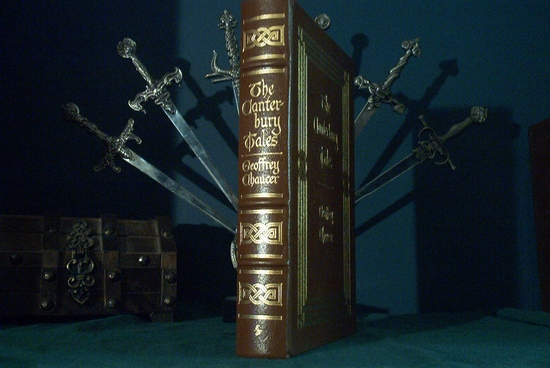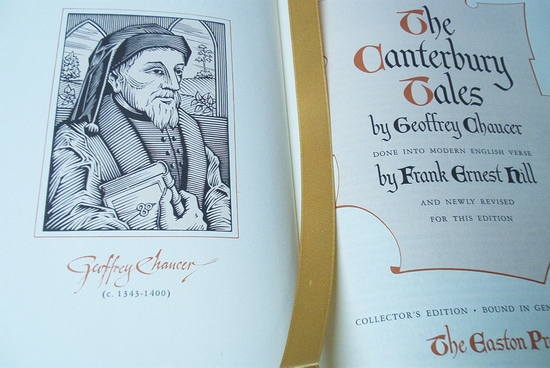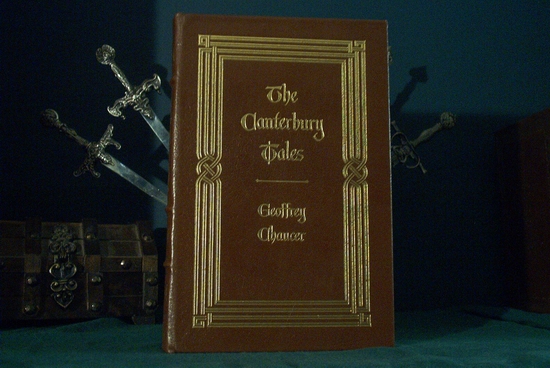Easton Press Geoffrey Chaucer books
Franklin Library Geoffrey Chaucer books
The Canterbury Tales - Collected Stories of the World's Greatest Writers - 1978
Troilus and Cressida - Great Books of the Western World - 1982
The Canterbury Tales - Great Books of the Western World - 2 volumes - 1983
Geoffrey Chaucer biography
Geoffrey Chaucer (1343-1400) was the first major English poet. He was born in London, and probably attended the Saint Paul's Cathedral School in London. Geoffrey Chaucer was a page in the home of Prince Lionel son of King Edward III. During the Hundred Years War he served with the English army in from 1358 to 1360 and was captured and eventually ransomed. Between 1361 and 1366 he may have studied law at the Inns of Court in London England. Geoffrey Chaucer married Phillippa de Roet, whose sister, Catherine Swynford, married John of Gaunt, another son of King Edward III, as his third wife. Between 1360 and his death Geoffrey Chaucer held a number of official positions and traveled a great deal for diplomatic reasons, and therefore must have been an important man of affairs. He journeyed often to France for government business, and at least twice to Italy, where, it is believed, he was first introduced to the books of famous Italian writers Dante Alighieri, Francesco Petarch, and Giovanni Boccaccio. Geoffrey Chaucer held the important and lucrative post of controller of the customs of wools, skins, and hides for England from 1374 to 1386, and lived during his posting to this position in a house above Aldgate, one of the gates to London. It is believed that he lived thereafter mainly in Kent, where he served as justice of the peace, and a member of Parliament. In 1389 he was appointed clerk of the King's works, which place him in charge of repair and construction of extensive Royal buildings. This position proved to be dangerous, because in a span of four days he was assaulted and robbed at least twice in 1390; he resigned the position in 1391. He was then appointed as deputy forester in North Petherton. Near the end of his life Geoffrey Chaucer apparently had the favor of King Richard II and King Henry IV, although it is believed that he suffered from financial troubles during this time. The books Geoffrey Chaucer wrote prior to 1382 are dominated by prevailing literary mode common to the late Middle Ages, characterized by symbolic interaction between allegorical or fanciful persons who seem to live in a dream world, or cut off from reality. Most of these Middle Ages poems are composed in the Octosyllabic couplet common in early medieval narrative verse. Geoffrey Chaucer's translation of Le Roman De la Rose, a popular 13Th century book, by French poets Guillaume de Lorris and Jean Clopinel, was probably written during this time prior to 1382. Among his other early books are The Book of the Duchess, a sensitive and evocative elegy in the form of dream vision, written in honor of Blanche, the first wife of John of Gaunt; the unfinished poem The House of Fame, a partly humorous, very fanciful dream vision in which Geoffrey Chaucer himself, in imitation of a more solemn scene in Dante's The Divine Comedy, is carried by a talkative eagle form the earth to a strange land; In The Parlement of Foules, also known as The Parliament of Birds, he is led in a dream into a garden, where he first enters a temple dedicated to goddess Venus and devoted apparently to romantic and sensual love, and then sees the judgement of Dame Nature in distributing mates to various birds representing various kinds of people. Part of the intention of Geoffrey Chaucer at this time was to portray love in marriage.
The books by Geoffrey Chaucer written in the later part of his life, generally depict solid individuals in the everyday world and contain some notable technical innovations in English Literature. During this time he made extensive use of rime royal stanza in his conservative, formal, or religious narratives, and he introduced the iambic pentameter couplet to English literature, using it in his satirical books. Geoffrey Chaucer relies again on dream vision in The Legend of Good Women, but passes to the successive stories of famous women whose love was villainously betrayed by their men. Troilus and Cressida, a romance based in ancient Troy, displays similarities to another romance of the same subject by Giovanni Boccaccio. However, the book by Geoffrey Chaucer differs in representing sensitively the psychological stages of the noble but inconstant Cressida's love for and desertion of the warrior Troilus. The poem succeeds in relating these occurrences to a larger view of man's fate, partly through the reactions of the wise character Pandarus. The book Geoffrey Chaucer is most famous for is The Canterbury Tales which was written between 1386 and 1400. The Canterbury Tales comprises a series of extraordinarily diverse tales and viewpoints tied together by revelations of the characters of the tellers, a band of pilgrims. Geoffrey Chaucer exhibits in this book his mastery of story telling and his unique understanding of humanity. In addition to The Canterbury Tales and the other books previously described, he also authored shorter poems, and other books, of which some have been lost to time.
As a result of his masterpiece The Canterbury Tales, Geoffrey Chaucer is viewed as one of the greatest authors of English literature. The qualities that have endeared his books to generations of readers are his unique understanding of humanity, and his creation of loving and unique characters. Geoffrey Chaucer brought together in literary books of a new subtlety and urbanity the courtly and idealized view of life common to medieval romance, the spiritual insight common to medieval religious books, and the robust and lusty perception of human frailty common in medieval satire. In Geoffrey Chaucer's time and the three prior centuries, French and Latin were the languages used by the upper classes in England. As a result, such classic books by Geoffrey Chaucer as The Canterbury Tales, The Parliament of Birds, and Troilus and Cressida were highly influential in establishing English as the common language of books in English literature. Following his death Geoffrey Chaucer was buried in Westminster Abbey, in what is known today as The Poets' Corner.
The Canterbury Tales is a long narrative poem written by Geoffrey Chaucer, probably between 1385 and 1400, and consisting of an introductory prologue and a number of tales, each with a prologue. Almost twice the length of Dante’s The Divine Comedy, it comprises over 17,000 lines of verse and 40,000 words of prose. Geoffrey Chaucer originally intended the Canterbury Tales to contain 120 tales, but the finished work numbers about 25 tales, several of which are incomplete. In the lengthy prologue at the beginning of the Canterbury Tales, Geoffrey Chaucer humorously but realistically introduces his characters, who are representative of most of the social classes of his day. The stories are thereafter linked by shorter prologues to make a continuous narrative. The Canterbury Tales concerns a group of pilgrims on their way to the shrine of Saint Thomas a Becket. At the suggestion of the host of Taberd Inn, in Southwark, a suburb of London, at the start of the journey, the pilgrims decide to relieve the tedium of their travel by telling stories. The best known tales are those told; by the knight, who contributes the first and longest story, a quasi-historical romance set in ancient Athens, generally considered the most beautiful of the tales; by the Nun’s Priest, who recounts a beast fable, the first important mock-heroic tale in English, treating of a fox and a cock who match wits; by the pardoner, who gives an illustrative sermon of the three revellers who met death; and by the wife of Bath, who tells an Arthurian fairy tale preceded by a long prologue in which she condemns celibacy by giving a frank account of her life with five successive husbands. Other tales are contributed by remaining members of the group, including a Nun, a Lawyer, a Student, a Cook, a Merchant, a Squire, a Physician, and Geoffrey Chaucer himself as one of the pilgrims. The tales told by the Canterbury pilgrims are chiefly of the literary types current in Chaucer’s day, such as the chivalric romance, the fabliau, the exemplum, the beast fable, and the legend. Most of the tales are borrowed and the sources are varied, so that Chaucer gives hot only a picture of England of the Middle Ages, but also a 14Th-century view of ancient Greece and Rome, and of Asia and continental Europe. Geoffrey Chaucer is chiefly concerned with the character of men as revealed in their conduct; he satirizes social class and sex, and broadly ridicules human weaknesses. The Canterbury Tales are regarded as the most brilliant achievement of the "father of English poetry".
The Canterbury Tales
The procession that crosses Chaucer's pages is as full of life and as richly textured as a medieval tapestry. The Knight, the Miller, the Friar, the Squire, the Prioress, the Wife of Bath, and others who make up the cast of characters including Chaucer himself are real people, with human emotions and weaknesses. When it is remembered that Chaucer wrote in English at a time when Latin was the standard literary language across western Europe, the magnitude of his achievement is even more remarkable. But Chaucer's genius needs no historical introduction; it bursts forth from every page of The Canterbury Tales.
If we trust the General Prologue, Chaucer intended that each pilgrim should tell two tales on the way to Canterbury and two tales on the way back. He never finished his enormous project and even the completed tales were not finally revised. Scholars are uncertain about the order of the tales. As the printing press had yet to be invented when Chaucer wrote his works, The Canterbury Tales has been passed down in several handwritten manuscripts.
Troilus and Crysede
Considered one of Chaucer’s finest poems, second only to The Canterbury Tales in richness and depth, Troilus and Cressida is a tragic love story set against the background of the siege of Troy by the Greeks. Written in the 1380s, it presents Troilus, son of Priam and younger brother of Hector as a Trojan warrior of renown who sees, and falls deeply in love with the beautiful Cressida. Cressida is the daughter of Calchas, a Trojan priest and seer who, having divined the eventual fall of Troy, has deserted to Agamemnon’s camp, leaving his daughter in the besieged city, With the help of Pander, friend to Troilus and uncle to Cressida, the young couple meet and merge – but with unhappy consequences. Chaucer’s long poem is cast in seven-line rhymed stanzas, and is eased out of Middle English to be presented here in a lively modern verse translation by George Philip Krapp, who has retained not only the structure, but its spirit. Emotions run high, the love is intense, the story unfolds with a dramatic urgency that draws the listener ever onwards; yet Chaucer is Chaucer, and there are times when a deft line, a light insinuation, suggests the smile, the benevolence and the immediacy of the author of The Canterbury Tales. Troilus and Cressida, though often overshadowed by the Tales and time (and even Shakespeare who took up the story) is a monument in its own right in the canon of English literature. Once read it will never be forgotten.


